Election for the governorship of the U.S. state of Ohio
| |||||||||||||||||
| |||||||||||||||||
| |||||||||||||||||
The 1893 Ohio gubernatorial election was held on November 2, 1893. Incumbent Republican William McKinley defeated Democratic nominee Lawrence T. Neal with 51.86% of the vote.
| |||||||||||||||||
| |||||||||||||||||
| |||||||||||||||||
| Elections in Ohio |
|---|
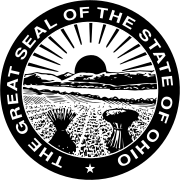 |
The 1893 Ohio gubernatorial election was held on November 2, 1893. Incumbent Republican William McKinley defeated Democratic nominee Lawrence T. Neal with 51.86% of the vote.
Major party candidates
Other candidates
| Party | Candidate | Votes | % | ±% | |
|---|---|---|---|---|---|
| Republican | William McKinley (incumbent) | 433,342 | 51.86% | ||
| Democratic | Lawrence T. Neal | 352,347 | 42.17% | ||
| Prohibition | Gideon P. Macklin | 22,406 | 2.68% | ||
| Populist | Edward J. Bracken | 15,563 | 1.86% | ||
| Majority | 80,995 | ||||
| Turnout | |||||
| Republican hold | Swing | ||||
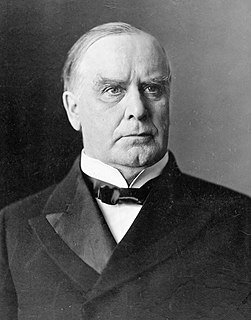
William McKinley was the 25th president of the United States, serving from 1897 until his assassination in 1901. He was president during the Spanish–American War of 1898, raised protective tariffs to boost American industry, and rejected the expansionary monetary policy of free silver, keeping the nation on the gold standard.

The 1896 United States presidential election was the 28th quadrennial presidential election, held on Tuesday, November 3, 1896. Former Governor William McKinley, the Republican candidate, defeated former Representative William Jennings Bryan, the Democratic candidate. The 1896 campaign, which took place during an economic depression known as the Panic of 1893, was a political realignment that ended the old Third Party System and began the Fourth Party System.

The 1900 United States presidential election was the 29th quadrennial presidential election, held on Tuesday, November 6, 1900. In a re-match of the 1896 race, incumbent Republican President William McKinley defeated his Democratic challenger, William Jennings Bryan. McKinley's victory made him the first president to win a consecutive re-election since Ulysses S. Grant had accomplished the same feat in 1872.
The Panic of 1896 was an acute economic depression in the United States that was less serious than other panics of the era, precipitated by a drop in silver reserves, and market concerns on the effects it would have on the gold standard. Deflation of commodities' prices drove the stock market to new lows in a trend that began to reverse only after the 1896 election of William McKinley. The failure of the National Bank of Illinois in Chicago is remembered as one of the motivating factors in the sensational Adolph Luetgert murder case. During the panic, call money would reach 125 percent, the highest level since the Civil War.
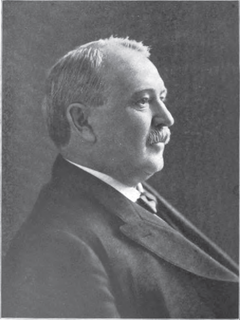
Lawrence Talbot Neal was an American lawyer and politician who served two terms as a U.S. Representative from Ohio from 1873 to 1877.
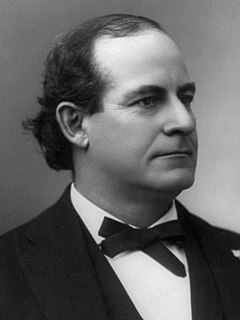
The 1900 United States presidential election in Missouri took place on November 6, 1900. Voters chose 17 electors to represent them in the Electoral College via a popular vote pitting incumbent Republican President William McKinley against Democratic challenger William Jennings Bryan.

The 1900 United States presidential election in Montana took place on November 6, 1900 as part of the 1900 United States presidential election. Voters chose three representatives, or electors to the Electoral College, who voted for president and vice president.
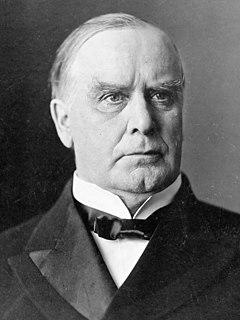
The 1900 United States presidential election in New York took place on November 6, 1900. All contemporary 45 states were part of the 1900 United States presidential election. Voters chose 36 electors to the Electoral College, which selected the president and vice president.

The 1896 United States presidential election in New York took place on November 3, 1896. All contemporary 45 states were part of the 1896 United States presidential election. Voters chose 36 electors to the Electoral College, which selected the president and vice president.

The 1926 United States Senate election in Illinois took place on November 2, 1926.

The 1966 United States Senate election in Alaska was held on November 8, 1966. Incumbent Democratic U.S. Senator Bob Bartlett was re-elected to a second term in office, defeating Republican dentist Lee McKinley in a rematch of their 1960 race.

The 1896 United States elections elected the 55th United States Congress. Republicans won control of the Presidency and maintained control of both houses of Congress. The election marked the end of the Third Party System and the start of the Fourth Party System, as Republicans would generally dominate politics until the 1930 elections. Political scientists such as V.O. Key, Jr. argue that this election was a realigning election, while James Reichley argues against this idea on the basis that the Republican victory in this election merely continued the party's post-Civil War dominance. The election took place in the aftermath of the Panic of 1893, and featured a fierce debate between advocates of bimetallism and supporters of the gold standard.

The 1920 United States Senate election in Illinois took place on November 2, 1920.

In 1896, William McKinley was elected President of the United States. McKinley, a Republican and former Governor of Ohio, defeated the joint Democratic and Populist nominee, William Jennings Bryan, as well as minor-party candidates. McKinley's decisive victory in what is sometimes seen as a realigning election ended a period of close presidential contests, and ushered in an era of dominance for the Republican Party.

The 1896 United States presidential election in Vermont took place on November 3, 1896 as part of the 1896 United States presidential election. Voters chose four representatives, or electors to the Electoral College, who voted for president and vice president.

The 1900 United States presidential election in Vermont took place on November 6, 1900 as part of the 1900 United States presidential election. Voters chose four representatives, or electors to the Electoral College, who voted for president and vice president.

The 1900 United States presidential election took place after an economic recovery from the Panic of 1893 as well as after the Spanish–American War, with the economy, foreign policy, and imperialism being the main issues of the campaign. Ultimately, the incumbent U.S. President William McKinley ended up defeating the anti-imperialist William Jennings Bryan and thus won a second four-year term in office.

The 1896 United States presidential election in Michigan took place on November 3, 1896. All contemporary 45 states were part of the 1896 United States presidential election. Voters chose 14 electors to the Electoral College, which selected the president and vice president.

The 1896 United States presidential election in Kentucky took place on November 3, 1896. All contemporary 45 states were part of the 1896 United States presidential election. Kentucky voters chose 13 electors to the Electoral College, which selected the president and vice president.

The 1891 Ohio gubernatorial election was held on November 3, 1891. Republican nominee William McKinley defeated Democratic incumbent James E. Campbell with 48.61% of the vote.